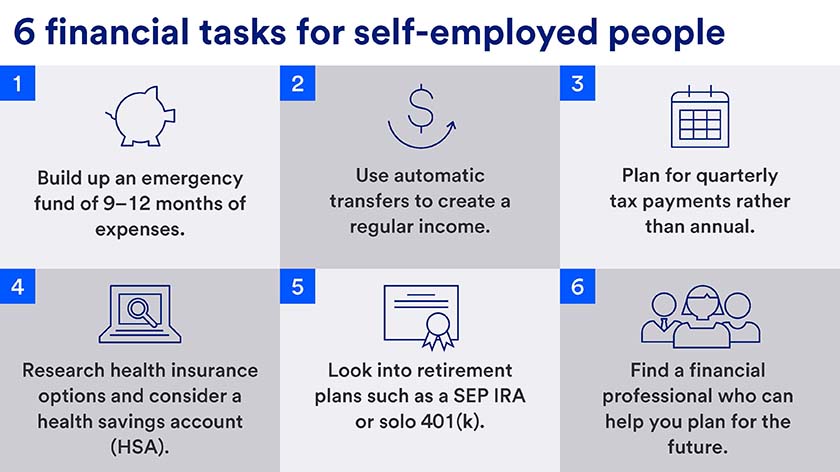Key takeaways
Cash flow, self-employment taxes and retirement planning are three important financial considerations for self-employed individuals.
Managing income and expenses can be done with software or with a traditional spreadsheet, both of which will help you plan for the different tax requirements you’ll be subject to.
Longer-term financial planning tactics for the self-employed can include health insurance, retirement accounts such as a SEP IRA, and an emergency fund.
Working for yourself can be a dream in many ways, but it can also come with business challenges, including cash flow, taxes and retirement planning. Having a plan that addresses these challenges means you can concentrate on creating a business that works for your skills, goals and lifestyle.
The strategies below can help you:
- Manage inconsistent cash flow from self-employment income
- Correctly navigate self-employment tax rules
- Choose the appropriate investment vehicles to support your retirement and other long-term saving goals
What are the sources of self-employment income?
Looked at through a tax lens, self-employment income can come from a few different sources. According to the Internal Revenue Service, you are generally considered self-employed if any of the following apply to you:
- You are a sole proprietor – in other words, you own an unincorporated business by yourself.
- You are an independent contractor, performing work for another person or entity.
- You are a member of a business partnership.
- You are otherwise in business for yourself, including running a part-time business or as a gig worker. Examples of this include having an Etsy shop or being a virtual assistant.
Managing your self-employment income
When you’re self-employed, creating a manageable cash flow is critical. To do this, you’ll need to be diligent about tracking your income and expenses and determining the flow of cash from invoice to bank account and out again.
Choosing a bank account for self-employment income.
You have a couple of options when it comes to where to keep your self-employment income.
- A business-only bank account could be the most appropriate option for independent contractors or small business owners. You can open a business checking and/or savings account with your Employer Identification Number (EIN).
- A personal checking account should suffice for gig workers and some 1099 contractors, such as freelancers who don’t have employees and few (if any) work-related expenses.
Tracking your self-employment income.
There are several software options to help self-employed people track income and cash flow, but you can also use a simple spreadsheet.
If you’d prefer to DIY, you can build a spreadsheet for each month that lists all the invoices you’ve sent to clients, when you sent them, their amounts and when they were paid. Give each client a separate row and keep a running total of the amount paid by each client during that month.
At the end of each month, tally the income from the invoices that were paid. Add that monthly subtotal to your year-to-date total income to help you understand the estimated taxes you’ll need to pay each quarter (more on this later).
Tracking when invoices are paid also helps you spot when certain invoices may have become 30 days past due, so you can then prompt your clients to pay them. One idea is to put unpaid invoice information in red, and then change it to black after an invoice is paid.
You should also include a separate section on your spreadsheet to track your monthly expenses – across all categories – to determine whether your income is creating the appropriate cash flow to meet your expenses for that month.
Take advantage of automatic transfers to create a regular income.
Budgeting for a personal salary can help address a common challenge for self-employed individuals: varying cash flow throughout the year. Automatic transfers can help create a “salary” that allows you to plan realistically.
- Automatic transfers from a business bank account to your personal account will create something like a regular paycheck. This can help you plan budgets and calculate taxes.
- Automatic transfers to longer-term accounts like an emergency fund, a savings account and your retirement accounts will build your savings and investments for short- and long-term goals. You can always adjust how much goes into each account as your income ebbs and flows.
Anticipate fluctuating monthly income
Unlike a salaried job, being self-employed means your income is likely to vary from month to month. Perhaps you’re busier during the holiday season and quieter in the summer months, or maybe you take on two major projects each year and rest or travel in between. This unpredictable – or at least uneven – income means it’s important to have a financial cushion in place to ensure you can cover your expenses even during slow months.
Having a plan that addresses self-employment financial challenges means you can concentrate on creating a business that works for your skills, goals and lifestyle.
The primary vehicle for this financial cushion is an emergency fund. For people on salaries, it’s often recommended that they build up enough money to pay for three to six months of expenses. But given the varying nature of freelance income and the more frequent tax payments due, you may want to keep an even larger buffer – perhaps nine to 12 months.
You’ll want to keep this cash in an account that’s easily accessible but will help your balance grow, so consider a money market account or high-yield savings account. Set up an automatic transfer from your personal or business bank account each month until you reach your emergency fund target amount.
Finding insurance coverage for self-employed individuals
Employers typically provide health, life and disability insurance to their employees. However, as a self-employed individual, you’re on your own when it comes to selecting and purchasing coverage.
State-based exchanges are a good place to start for browsing health insurance options. Life and long-term disability insurance may also be critical if you have family depending on your income. Make sure to look for an “own occupation” policy tied to your specific career.
If you have a high-deductible insurance plan, consider opening a health savings account (HSA), which is a tax-advantaged way to save for medical expenses as well as retirement.
Self-employment tax planning
Tax planning is one of the more challenging aspects of being self-employed. Instead of your employer taking care of federal and state tax withholdings, you’ll need to do it yourself.
There are two primary tax considerations for self-employed individuals:
- You’re generally required to file an annual income tax return if your net earnings from self-employment were $400 or more in a given tax year.
- In addition to federal income taxes, you must also pay a federal self-employment tax, similar to the Social Security and Medicare taxes that are withheld from most wage earners’ paychecks. As your own boss, you pay the combined employee and employer Social Security tax rate of 12.4% on up to $168,600 of your net earnings, and the 2.9% Medicare tax on your entire net earnings.1
Fortunately, there are a number of self-employment income tax deductions to help offset the share of the taxes that an employer would usually cover, including the self-employment tax deduction, the deduction for self-employed retirement plan contributions, and the qualified business income deduction.
To determine the type and amount of taxes you’ll likely need to pay, you must figure any net profit or net loss from your business using the calculations on the IRS’ Schedule C. On this form, you can offset your self-employment income with business deductions, including the home office deduction available for homeowners and renters. Then, on Form 1040, after you have calculated the total income tax you owe, you can reduce that tax with business credits.
It's worth noting that eligibility for Social Security benefits also requires that you work and pay tax for a certain length of time to accumulate credits. The necessary amount depends on your date of birth, but nobody needs more than 40 credits (or 10 years of work).
Self-employed people pay taxes quarterly, not annually.
For each year that you expect to owe at least $1,000 in taxes – including self-employment tax – you must pay estimated taxes quarterly. Self-employed individuals generally use Form 1040-ES to figure estimated tax.
As a rough guide, you can expect to pay taxes of roughly 30% to 35% of the income you make each quarter – which could include paying estimated state taxes if you live in a state that imposes a state income tax. The percentage you pay could also change if you file a joint return with your spouse.
If you don’t pay enough estimated tax each quarter, you may have to pay a penalty. You also may have to pay a penalty if your estimated tax payments are late, even if you are due a refund when you file your tax return.
Be diligent about reporting your entire self-employment income. Many self-employed people receive 1099 forms from their clients that account for the total amount the clients paid them each year. They can use this information to tally their entire self-employment income for the year. Clients are also obliged to send copies of the 1099 forms to the IRS, so the agency can then verify the accuracy of the income you report. While clients are not required to send a 1099 form if they paid you less than $600 during the year, you are still required to report that income on your tax return – as well as all income you received in cash.
Retirement for self-employed individuals
As a self-employed individual, you are the employer and the employee when it comes to employer-sponsored retirement plans. You have access to the same IRS tax qualified retirement plans as an employer with multiple employees, which can provide tax advantages and enhanced savings options potentially greater than just an IRA.
Research retirement plans for self-employed individuals, such as a Simplified Employee Pension (SEP) IRA, or Individual (Solo) 401(k) plans, which have some of the same tax advantages available to traditional employees. Then, set up automatic transfers to your account. A financial professional can help you navigate the options.
Once you are retired, distributions from traditional IRAs, SEP IRAs or Solo 401(k)s are considered taxable income. Roth IRA or Roth 401(k) plan distributions are not taxed when withdrawn at retirement when certain requirements are met.
Be sure to carefully review your situation with your tax professional to determine which qualified retirement plan option works best with your business structure, tax, and savings needs.
When it comes to managing your self-employment income, including self-employment taxes, there’s no getting around the fact that more administrative responsibility rests on your shoulders than it would if you were a traditional full-time employee. But by putting the proper systems in place to track your income, expenses and expected taxes, and building up a financial buffer, you can enjoy the full benefits of being your own boss.
A financial professional can help bridge the gap between your business and personal finances. Find a wealth specialist in your area.
Explore more
Self-employed retirement accounts: 5 options to consider
Self-employed individuals have more freedom, but you must take responsibility for your own financial security in retirement.

Our goals-focused approach puts you first.
We can help you identify and prioritize your financial goals and design a plan to work toward them, making adjustments as your needs evolve.



